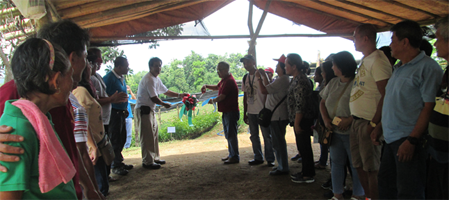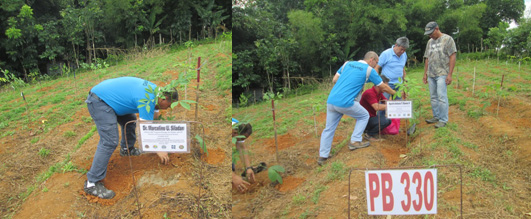 The University of the Philippines Los Baños (UPLB) and the Philippine Council for Agriculture, Aquatic, and Natural Resources Research and Development of the Department of Science and Technology (DOST-PCAARRD) conducted the official inauguration of the established rubber nursery and budwood garden in Cavinti, Laguna.
The University of the Philippines Los Baños (UPLB) and the Philippine Council for Agriculture, Aquatic, and Natural Resources Research and Development of the Department of Science and Technology (DOST-PCAARRD) conducted the official inauguration of the established rubber nursery and budwood garden in Cavinti, Laguna.
The activity was done as part of the project, “Establishment of Rubber Nursery, Budwood Garden, and Demonstration Farm in Cavinti, Laguna: A Science and Technology-based (S&T) Community-based Farm (STCBF) Approach.”
The established rubber nursery and budwood garden aims to supply certified clones to plantations around CALABARZON and eventually, become an accredited source of high quality budded seedlings and budsticks across Luzon.
 Dr. Antonio F. Gascon, project leader, along with his team from the Institute of Renewable Natural Resources in the College of Forestry and Natural Resources of UPLB (IRNR, CFNR-UPLB), spearheaded the activity.
Dr. Antonio F. Gascon, project leader, along with his team from the Institute of Renewable Natural Resources in the College of Forestry and Natural Resources of UPLB (IRNR, CFNR-UPLB), spearheaded the activity.
A total of 55 individuals participated in the opening program, including Dr. Marcelino U. Siladan, PCAARRD Industry Strategic S&T Program (ISP) Manager for Rubber of the Forestry and Environment Research Division and Mr. Agustin Antonio V. Ramos V of the Technology Transfer and Promotion Division, DOST-PCAARRD.
Representatives from DOST IV-A, Southern Tagalog Rubber Producers Cooperative (STRPC), and the Municipal Government of Cavinti, Laguna also supported the activity. Moreover, residents of Mahipon, Cavinti made use of the opportunity to collaborate with other agencies and stakeholders for future project activities.
The tree planting activity in the budwood area, as one of the highlights of the program, involved all the participants in the planting of different rubber clones, namely: USM 1, RRIM 600, PB 217, PB 235, PB 260, PB 311, and PB 330. Seedlings used in the budwood garden were all budded, while seedlings raised in the nursery would serve as root stocks for future budding activities.

